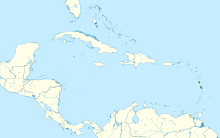Blue headed hummingbird
| Blue headed hummingbird | ||||||||||
|---|---|---|---|---|---|---|---|---|---|---|

Blue-headed hummingbird ♂ |
||||||||||
| Systematics | ||||||||||
|
||||||||||
| Scientific name of the genus | ||||||||||
| Cyanophaia | ||||||||||
| Reichenbach , 1854 | ||||||||||
| Scientific name of the species | ||||||||||
| Cyanophaia bicolor | ||||||||||
| ( Gmelin, JF , 1788) |
The blue-headed hummingbird ( Cyanophaia bicolor ) is a species of bird in the hummingbird family (Trochilidae). The range of the species includes the islands Martinique and Dominica . The IUCN assesses the population as Least Concern .
features
The male blue-headed hummingbird reaches a body length of 9-10 cm with a weight of 4.7 g, the female with 4.5 g also a body length of 9-10 cm. The male has a straight black bill that is partly pink at the base of the lower mandible. The head is metallic violet-blue, the back shimmers green. The upper tail ceilings are deep blue. The chin and throat are purple blue, the rest of the underside metallic green with a dull blue tint. The forked tail is steel blue. The female has a beak similar to that of the male. But this one is completely black. The head shines green, with the cheeks and ears appearing darker. There is a gray spot behind the eye. The back is bronze green. The underside is colored pale brownish-gray, the sides bronze-green. The tail shimmers bronze at the base. The outer control feathers are adorned with a blue subterminal band with large gray spots. Immature blue-headed hummingbirds resemble fully grown females, but the head feathers are light green with brown borders.
behavior
The blue-headed hummingbird is a resident bird . He gets his nectar from the lower strata to the treetops. The plants that he u. a. flies, belong to the genera Pachystachys , silk plants ( Asclepias ), Begonia ( Begonia ), Costus , Besleria , Duranta and Inga . To do this, he hunts insects near mountain rivers and collects arthropods from the leaves.
Vocalizations
The call sounds like a high-pitched metallic sound that quickly decreases in pitch. There is also a metallic click-click-click .
Reproduction
They breed from March to May. Your goblet-shaped nest consists of plant fibers such. B. from the fluff of cotton trees or soft parts of fern trees. They place these at a height of one to four meters on horizontal branches or fern tips. Mostly they decorate them with strips of dead heliconia leaves or ferns. They lay two eggs in the nest, which the female hatches for 16 to 18 days. The chicks are flesh-colored with a light gray. The young birds 20 to 23 days Nesthocker . The young animals then stay with their mother for three to four weeks. They have their first brood in their second year of life.
Systematics
According to more recent phylogenetic studies, the genus Cyanophaia is considered paraphyletic with the genus Chlorostilbon .
Etymology and history of research
Johann Friedrich Gmelin described the hummingbird under the name Trochilus bicolor . The type specimen supposedly came from Guadeloupe . In 1854 Heinrich Gottlieb Ludwig Reichenbach introduced the genus Cyanophaia , which he a. a. assigned the blue-headed hummingbird. »Cyanophaia« is derived from the Greek »cyanos κυανος « for »dark blue« and »phaios φαιος « for »dark, gloomy«. The species name is made up of the Latin words "bi" for "two" and "color" for "color".
literature
- Karl-Ludwig Schuchmann , Peter Boesman: Blue-headed Hummingbird (Cyanophaia bicolor) in Handbook of the Birds of the World Alive . Lynx Edicions, Barcelona.
- James A. Jobling: Helm Dictionary of Scientific Bird Names . Christopher Helm, London 2010, ISBN 978-1-4081-2501-4 .
- Johann Friedrich Gmelin: Systema Naturae per Regna Tria Naturae, Secundum Classes, Ordines, Genera, Species, Cum Characteribus, Differentiis, Synonymis, Locis . tape 1 , no. 1 . Georg Emanuel Beer, Leipzig 1788 ( biodiversitylibrary.org ).
- Heinrich Gottlieb Ludwig Reichenbach: Enumeration of the hummingbirds or trochilids in their true natural relationship with key to their synonymy . In: Journal of Ornithology . tape 2 , special issue, 1854, p. 1-24 ( biodiversitylibrary.org ).
- Jimmy Adair McGuire, Christopher Cooper Witt, James Vanderbeek Remsen Jr, Ammon Corl, Daniel Lee Rabosky, Douglas Leonard Altshuler, Robert Dudley: Molecular phylogenetics and the diversification of hummingbirds . In: Current Biology . tape 24 , no. 8 , 2014, p. 910-916 , doi : 10.1016 / j.cub.2014.03.016 .
Web links
- Cyanophaia bicolor inthe IUCN Red List of Threatened Species 2016.3. Posted by: BirdLife International, 2016. Retrieved March 14, 2017.
- BirdLife International: Species Factsheet - Blue-headed Hummingbird ( Cyanophaia bicolor ) . Retrieved March 14, 2017.
- Videos, photos and sound recordings of Blue-headed Hummingbird ( Cyanophaia bicolor ) in the Internet Bird Collection
- Blue-headed hummingbird ( Cyanophaia bicolor ) at Avibase; accessed on March 14, 2017.
- Cyanophaia bicolor in the Integrated Taxonomic Information System (ITIS)
- xeno-canto: sound recordings - Cyanophaia bicolor
Individual evidence
Remarks
- ↑ This genus he also ordered the blue face-Broad-billed Hummingbird ( Cynanthus doubledayi ( Bourcier , 1847)), the blue-throated Hummingbird ( Lepidopyga coeruleogularis ( Gould , 1851)) (synonym: Trochilus duchassaini Bourcier , 1851) and the Red-Sabrewing ( Campylopterus falcatus ( Swainson , 1821)) (Synonym: Le Colibri Lazulite Trochilus lazulus Vieillot , 1823. Other authors see an extinct species in Vieillot's description.).

